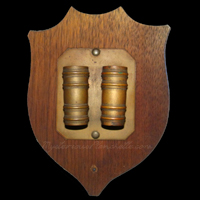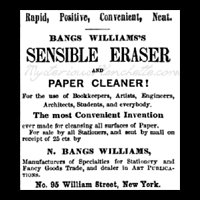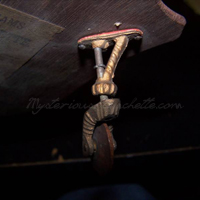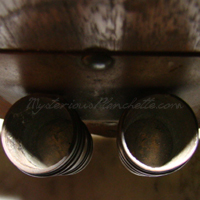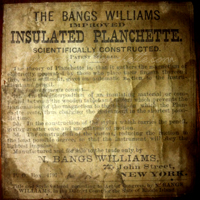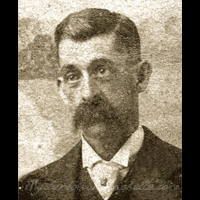Nathan Bangs Williams (1832-1899) was a prominent New York publisher, Civil War militiaman, Wall St. speculator, and tortoise shell manufacturer. Like other planchette makers of his era, he operated among his numerous other concerns a successful periodical shop that he had opened in Providence in 1853, which according to his obituary was for some time Rhode Island's largest bookstore. From this location he also ran a successful wholesale business and published a number of papers, including the Trumpet and the Evening Telegraph. Like other stationers of his day, Bang Williams was perfectly positioned to take advantage of a new craze.
Williams was quite a character, and in 1861, published a New Year's address to his patrons, written totally in rhyme and lampooning national political events while also advertising his own products! He served 3 months in the Rhode Island detached militia during the Civil War, and in early 1868 had sold out of his Providence businesses and moved to New York. There, he set up a shop employing 15 workers in the manufacture of various goods, including lubricators and oil cups for the railway business, "sensible" erasers for the stationary trade, and his stylish and unique Insulated Planchette. Evidence suggest his company was even exporting his Insulated Planchette to Cunningham's: a prominent Australian dealer! His fortunes in New York were not as blessed as his earlier endeavors, and despite numerous patents in engine parts and even backgammon board game improvements, he gambled on Wall Street and lost everything, declaring bankruptcy in January of 1870.
The background of Bang Williams is similar to other planchette manufacturers of the era, entrenched as they are in the book trade, and given the relative ease of construction of planchettes themselves, it comes as little surprise that men of enterprise such as Bang Williams capitalized on the new craze. But the "Insulated Planchettes" produced by his firm are far from an attempt to turn a quick buck, because they are truly works of art. The stylized shield design is unique among planchettes, as are the gold-painted pot-metal castors displaying art deco-inspired vine work. The wood-wheeled castors are attached with tiny nails, and sandwiched between their base and the board is a thin sliver of red "insulating" rubber which no doubt gives the planchettes their name. The pencil clamp is similarly unique, displaying matching embellishments with a simple and clever tension design to hold the pencil firmly.
But perhaps the most interesting aspect of these "scientifically constructed" planchettes is the bizarre attachment nailed to the topside of some existing examples. It is apparent from the lack of nail holes on other discovered planchettes that this feature was not universal among the company's planks. On those that did include the attachment, it consisted of a brass plate supporting a pair of parallel twin tubes, each about 3-inches long and somewhat corrugated. The amazingly esoteric and bizarrely-punctuated instructions explain this "improvement" in some detail:
"The theory of Planchette is, that it gathers the magnetism or electricity generated by those who place their fingers thereon; this, when sufficient, gives an automatic reaction to the instrument and pencil. The improvements consist of:
1st. In the interposition of an insulating material or compound between the wooden tablet and castors which prevents the transmission of the magnetism to the table upon which the Planchette rests, thus charging the instrument in the shortest possible time.
2d. In the construction of the stylus which carries the pencil, giving greater ease and smoothness of motion.
3d. The construction of the castors, reducing the friction to the least possible degree, so that the instrument will obey the lightest impulse."
Lastly, with the help of a specimen in the collection of talking board collector Andrew Vespia, we may have identified the actual original owner of his Bang Williams planchette! Unlike other examples, Mr. Vespia's planchette has the remnants of a smeared ink stamp on its underside. After forensically examining the details of the stamp, we were able to determine a name and address: John F. Burgum, 40 Central Square, Keene, NH. The date is too smeared to determine accurately, but appears to be 1887.
John Burgum was a cabinetmaker, wood stainer, and ornamental painter, and while we initially thought that this clue was leading us to the identity of Bangs Williams' wood blank-cutter, it is more likely that this shop stamp was merely a mark of ownership. Seems like the kitchen cabinets of some old New Hampshire homes might have been crafted by a Spiritualist! His obituary reports that Burgum died tragically in a fire in his woodshop, where he also slept. We're glad that his planchette survived to provide this rare and unique glimpse into the previous ownership of the item!






